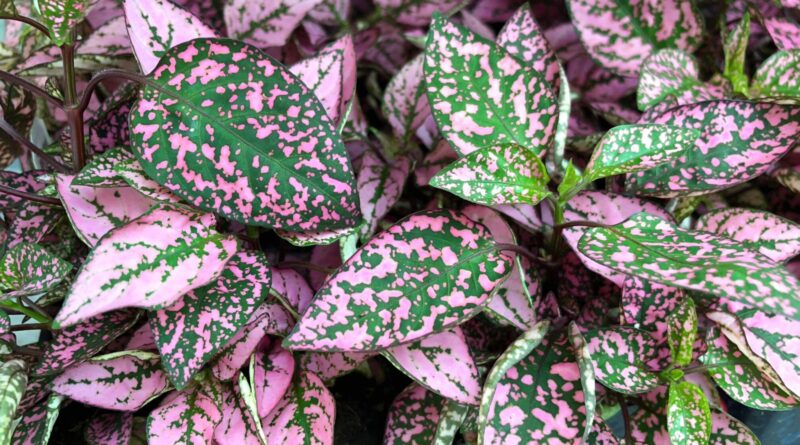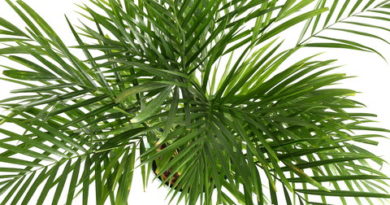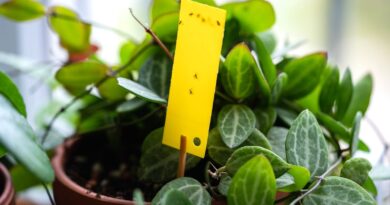How to Plant, Grow, and Care for Polka Dot Plants
A splash of color in the garden or a pot next to other greenery indoors are always attractive features. This is why Hypoestes phyllostachya (polka dot plant) has become popular in the houseplant world. In warmer regions, it can be grown as an annual outdoors.
These plants are easy to care for as long as you provide the correct light, a good amount of moisture, and a regular feeding schedule throughout the growing season. The soft pink foliage makes it a gentle yet colorful addition to any houseplant collection.
Plant Overview


|
|
|
|
What Is Polka Dot Plant?
Hypoestes phyllostachya is a leafy perennial or annual with insignificant flowers cultivated for its special pink speckled foliage. This ornamental plant is native to the tropics and can brighten up a terrarium or houseplant collection.
In cold climates, this frost-tender perennial grows best indoors, but in warm climates, it can be grown outdoors in containers or hanging baskets as an annual.
Native Area


The origins of Hypoestes phyllostachya fall mostly in Madagascar, but it is also native to South Africa and East Asia. It has been introduced to a tropical regions of North and South America as well as parts of India.
This is by far the most popular plant of the Hypoestes genus. However, there are over 200 other Hypoestes varieties, ranging from small ground cover type plants to large shrubs. Many have similar patterns on their leaves and are native to other tropical and subtropical areas of the world.
Characteristics


Freckly leaves are what set this plant apart. The foliage comes in a variety of colors from green and light pink, dark green and dark pink verging on red, and white and green. The leaves are soft and hairy.
If not confined to a container, they can grow to 30 inches high. Normally, however, the plants remain quite small, at around six to eight inches.
The flowers are small and tubular purple. They may emerge in summer and into autumn. The name Hypoestes originates in the Greek language— hypo means ‘under’ and estia means ‘a house,’ referring to the flowers that are hidden under bracts and hardly noticeable.
This unique species is a recipient of the coveted Royal Horticultural Society’s Award of Garden Merit.
Planting
Whether planted in the garden, in a pot to use as a houseplant, or in a terrarium, these are the requirements this species needs to thrive. Stressed plants are more prone to pests and diseases, so proper care prevents problems down the line.
Transplanting


Polka dot plants hate to have their roots disturbed, so it’s best to repot only if necessary. Only increase the pot size by a maximum of two inches. When transplanting to new soil, disturb the roots as little as possible or they will suffer from transplant shock. It’s best to repot in spring.
Growing from Seed


These plants are easily grown from seed. If you are planning to plant them outdoors, start seed sowing indoors or in a greenhouse 8-10 weeks before the last frost date. Keep the temperature at around 68°F (20°C), and seeds should sprout in 4-5 days.
Once the plants have reached around 3 inches tall and have two sets of true leaves, they can be planted into individual pots. If you intend to sow seeds for plants as houseplants, you can propagate at any time of the year.
How to Grow
These easygoing houseplants have simple and straightforward growing requirements.
Light


To keep their foliage nice and bright, these plants need medium to bright indirect light. They tolerate low light areas but their foliage may lose color in shady spaces. Avoid direct sunlight, which may scorch the leaves and bleach out the colors.
Water


This tropical native medium water requirements. Evenly moist soil is best. Avoid overly dry or overly wet soil. Don’t allow the plants to sit in water; rather, let the water drain freely from the pot before adding it back into pot covers or trays. Water more in hot and dry conditions. Any signs of limp foliage will be a pointer to give it more water.
Soil


In pots, this species does well with a standard commercial potting soil that is well-draining. Add vermiculite or perlite to the mix to increase drainage. The soil pH can be slightly acidic to neutral.
If planting in the garden, they prefer a rich, well-draining soil. Avoid clay soil or enhance it with plenty of extra organic material and compost. When planting, add a good deal of compost to the area and keep it well-watered while transplants get established.
Temperature


The ideal temperature range for these tropical plants is very warm, between 63-80°F (17-27°C). This is easily achieved in an indoor environment; just make sure the plants are out of range of cold drafts from outside.
They can only be grown outdoors in USDA hardiness zones 10-11. Outside of those zones, grow them in containers and take them in when temperatures drop in fall.
Humidity


As tropical natives, these plants like extra humidity with daily spritzing. They prefer humidity levels of 50% or higher.
Fertilizing


Feed these houseplants every two weeks from spring to autumn with a liquid plant food. Avoid feeding in winter. For outdoor plants, feed as you would your other annuals and bedding plants using a slow-release general-purpose fertilizer or liquid plant food.
Maintenance


As these houseplants get older, they may become leggy. To avoid this, pinch out the growing points to make bushier plants. Eventually, some plants need to be replaced with fresh new growth. You can take stem cuttings to propagate more.
Propagation
Stem cuttings are the preferred method and the easiest way of propagating polka dot plants. However, they can also be grown from seed.
Stem Cuttings


Use sharp, sanitized shears to take cuttings about four inches long from a stem with several visible nodes (growing points). Remove all but the top two to three leaves, and place each cutting in clean water. You can hold them up in a glass container by covering the top with plastic wrap, secured with a rubber band, and then poke holes in the plastic for each cutting.
Don’t crowd too many cuttings in one container. Give them space and airflow. Change the water twice a week. When the roots are about two and a half inches long, transplant them into pots with fresh potting soil.
You can also grow cuttings in seedling mix, vermiculite, or coarse sand. Make a hole in the substrate using the back of a pencil or a wooden. Insert the cutting and backfill. Dipping the ends in rooting hormone can speed up the process.
Keep cuttings watered and warm. Within two to three weeks, they should have sufficient roots to up-pot. Give the plants a gentle tug to check if they’ve rooted. If they feel firmly stuck in the soil, they are ready to go!
Popular Varieties
There are many popular varieties, but they all have very similar growth requirements.
‘Confetti’


‘Confetti’ is a compact plant with pretty foliage in colors that range from bright white and dark green, blush red and green, to baby pink and dark green. Sometimes, they are an intense very dark pink to red with a dark forest green background.
‘Splash’


‘Splash’ is a compact variety with uniform markings and a mounding habit.
‘Pink Brocade’


‘Pink Brocade’ is a more freckled variety in pink and green with vigorous growth.
‘Hippo’


‘Hippo’ has large, colorful leaves and lush growth in bright color combinations.
Common Problems
These houseplants are fairly low key, but here are a few problems you may encounter and how to solve them.
Too Much or Too Little Light


When leaves start losing color and becoming pale, dry, or brittle, the plant is getting too much direct sunlight. It will also lose its color in areas with not enough light. The middle of the road is best for this plant to keep the vibrant foliage. Move your plant to an area of your home a few feet back from a bright window.
Too Cold


If the plants are exposed to temperatures below 50°F (10°C), they may suffer from cold damage and begin to drop their leaves. Keep away from drafty areas, air conditioners, and open windows.
Overwatering


Excess water can cause the leaves to yellow. To fix the problem, reduce the watering cycle and check the soil drainage. The plant may also suffer from root rot if the soil is poorly drained. Remove any yellowing leaves, cut back on watering, and repot if necessary.
Underwatering


When you see limp leaves, the plant is telling you that it needs water. This is an easy fix, but it may take a bit of time to recover, so keep an eye on it.
Pests and Diseases


These plants are not bothered by many pests unless they are stressed by too much light, under or overwatering, or cold temperatures. On the rare occasion you do have problems, look out for mealybugs, aphids, and whitefiles. Wipe the leaves with a diluted neem solution to remove the pests.
Powdery mildew and root rot are also issues that can arise when plants are overwatered. These two diseases also strike in media that doesn’t drain well. For powdery mildew, remove damaged leaves as they crop up and replant in fresh soil if the problem persists. The same can be done for root rot after removing damaged roots.
Frequently Asked Questions
Watering frequency depends on the time of the year, soil type, and humidity levels. The best way to know if you need to water is to check the soil. If it’s damp, then leave it a day or so. But if the soil feels dehydrated to the touch, add water. On average, check your plants’ moisture every 4 days during the summer.
You can divide these plants, but they grow so well from cuttings that it is usually unnecessary. They dislike root disturbance, so propagating by cuttings is best. If your plant becomes leggy, it may be time to retire it to the compost heap.
Most will live as houseplants for up to five years in ideal conditions. Before that time is up, it’s best to make some cuttings to grow more plants.
This plant is considered non-toxic. It is completely safe for pets like cats, dogs, and horses and is also non-toxic to humans. However, it’s not edible and you shouldn’t eat it.
Final Thoughts
The colors of polka dot plants make them stand out. The decorative combination of pink and green leaves make them very popular. There is also something to be said for planting many varieties together in a hanging basket to brighten a space. Don’t forget to provide plenty of warmth, humidity, and indirect light to help these plants thrive.




